Through the generosity of the OPA’s Shirl Smithson Scholarship, I attended Kathy Anderson’s flower painting class at the Scottsdale Artists’ School. While I’d loved Kathy’s work for many years, it was once I’d met her, and subsequently watched her DVD, that it became obvious that she was as skilled an instructor as she is a painter – particularly important to me because I take very few workshops, and have learned along the way that an artist’s excellence at the easel has absolutely nothing to do with whether he or she is a talented teacher.
Having approached the workshop with some specific goals in mind, I’d like to share how they were met from my own perspective as a commissioned portrait artist – things that were different, those that were similar, and how I experienced addressing the challenges. My goals in taking the workshop:
- To understand the disciplined use of transparent and opaque pigments and the use of washes to get desired results;
- To achieve the clean color for which Kathy’s work is so widely recognized; and
- To manage edges in a more cohesive and creative fashion.
Set-up
Unlike some other workshop situations, Kathy had us each select our flowers from a huge variety of fresh planted flowers from a nursery, encouraging students to choose flowers that we thought were beautiful. Although it took more time up front (compared to Kathy setting up our compositions for us in advance), it accomplished several things right away: we each could choose to paint subject matter that was individually exciting to us; it gave us time to examine and explore the structure of each different flower in our set-ups; and it forced us to consider a design that had movement and areas of both energy and rest, compositional elements that she stressed throughout each demonstration.

Kathy stressed the importance of having a design that works as well as possible, from the beginning, commenting that her plein-air kit contains (among other things) clips and bungee cords to move stuff that needs to be adjusted. I found this micro-solution for my azalea branch in one of the drawers in the student lounge.
Lighting
The taborets were lit by daylight-corrected bulbs – probably about 5000-5500 degrees K, lending warmth to the shadowed areas. This color temperature seems to be prevalent an Kathy’s floral and still life paintings, and is what one would expect in a garden from life, in conditions other than strong direct sunlight where lighting is subject to rapid change resulting from time and climate conditions.
Materials selection
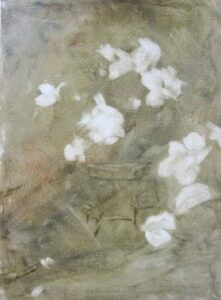
The Demonstrations
Kathy’s daily demonstrations were thorough and varied. They focused on alla-prima approaches to painting the floral still life, always emphasizing the importance of a lyric design, variety of color, shapes and angles, and the joy that has to precede doing them (well, anything actually) really well. As the composition developed Kathy described Nancy Guzik’s approach to finding places to paint “little triangles”, serving as directional arrows though their dark values and the crisp edges they create.
However, Kathy also demonstrated continuing to work on the painting from life during a second day, as well as taking photos at the first session in order to be sure to preserve the things that are most exciting- flowers, just like humans, can tend to droop after too much time on stage ☺
Also extremely valuable was her demo on how to go back into a painting that is dry to make adjustments or to complete the piece. The only reason – and I completely concur with this- artists can paint successfully from a photograph is because they have had extensive experience painting from life. Photographs lie to artists in the ways we most desperately need truth: color, value and edges. I firmly believe that learning has to be done from life – regardless of whether portrait, landscape, or floral subjects- and only after many, many canvases, can photos be interpreted in the best, most convincing manner.
The Opening
 On Thursday night, Scottsdale’s Legacy Gallery hosted a two –person show with works by Kathy Anderson and Mark Boedges (spectacular landscape painter). Although I wasn’t able to attend, fellow student Josi Callan shared photos from the opening. Legacy’s Scott Jones dropped in several times during the week, and couldn’t have been a better ambassador/advocate for artists everywhere. (Look for future information on Scott and his insights into gallery-artist relationships).
On Thursday night, Scottsdale’s Legacy Gallery hosted a two –person show with works by Kathy Anderson and Mark Boedges (spectacular landscape painter). Although I wasn’t able to attend, fellow student Josi Callan shared photos from the opening. Legacy’s Scott Jones dropped in several times during the week, and couldn’t have been a better ambassador/advocate for artists everywhere. (Look for future information on Scott and his insights into gallery-artist relationships).
Because I am fortunate to live only a few minutes from Legacy Gallery, I had the chance to visit on a quiet day after the opening and to spend as much time as I wanted drinking in Kathy’s fabulous paintings, each of which offered a silent, retrospective review of all that she’d taught the previous week.
In Summary
Yes, you should take the opportunity to study with Kathy Anderson. If you like learning from DVDs, buy hers. Kathy is as generous and warm as she is on her video. I don’t think there is ever a time when an artist should stop being challenged, stop studying or stop trying new things. Choose your instructors with care. Show up to class with the right materials and most importantly, the right attitude. Your time is too valuable to waste.

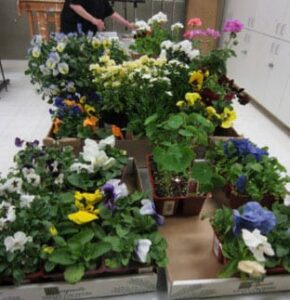

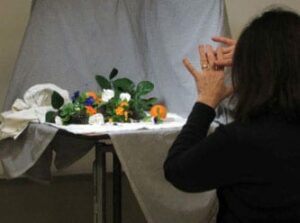
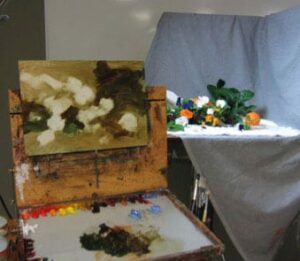
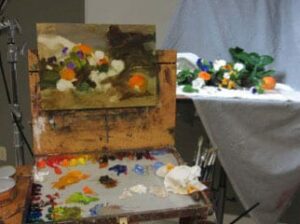
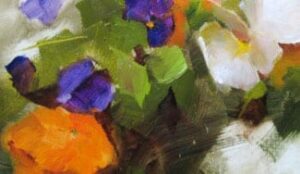
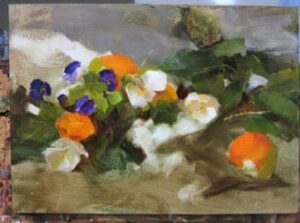
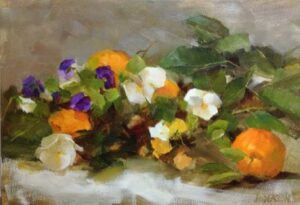
Ann Kraft Walker says
Great blog, Chris! I have Kathy’s DVD and can’t wait to view it. Wish I could have been in the class with you!
Chris Saper says
Annie, you will really enjoy it! I wish you would have been in class as well, but so glad I was able to see you last week in Atlanta:)
Ann Kraft Walker says
Me too! excellent post!!
Suzie Greer Baker says
Thanks Chris – so much great information here! I love the statement that photos lie to artists in the ways we desperately need the truth: color, value and edges – I’m so gonna use that when I teach. Thanks for sharing your experience with us.
Chris Saper says
You are more than welcome, I am appreciative for the opportunity to write the article, and especially being able to attend this class on my OPA scholarship:)
lori says
Where can you find the dvd?
Kruelski Edward says
i knew her when ( as an artist in Ct ) , and it’s so good to read/see how her skills/career has progressed ! thx 2u for this blog 🙂 your portrait work/tutorials are admirable !
Chris Saper says
Thank you so much! Kathy is a gracious and attentive instructor:)
Pamela Nichols says
I am streaming Kathy Anderson’s DVD now, about 20 minutes into it, and I had to stop and comment/thank you for writing this blog. Kathy’s excitement for the painting she has just begun makes me want to jump up and put some paint on a canvas! By the way, I didn’t think twice about this purchase after seeing your gorgeous “Debbie’s Garden.” Such a lovely little painting! Thank you once again for great guidance, Chris!